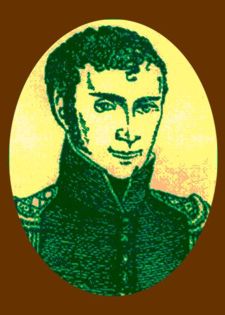Johann Wilhelm Ritter (1776-1810)
 Ritter was born in Samitz, Silesia (now Poland) and began his career as an
apothecary. He went to the University of Jena in 1796 to pursue his interests
in science. It was at Jena that he experimented with silver chloride. Although
it was known that AgCl decomposed in light, Ritter found that this process was
most efficient in the presence of “invisible” radiation, beyond
the violet end of the spectrum. This radiation became known as ultraviolet radiation.
Ritter was born in Samitz, Silesia (now Poland) and began his career as an
apothecary. He went to the University of Jena in 1796 to pursue his interests
in science. It was at Jena that he experimented with silver chloride. Although
it was known that AgCl decomposed in light, Ritter found that this process was
most efficient in the presence of “invisible” radiation, beyond
the violet end of the spectrum. This radiation became known as ultraviolet radiation.
In 1800, only months after the English chemist William Nicholson succeeded in decomposing water into hydrogen and oxygen by electrolysis, Johann Ritter duplicated the experiment but arranged the electrodes so that he could collect the two gases separately, thus improving on the experiments of Carlisle and Nicholson. Soon thereafter he discovered the process of electroplating. He observed that he could get metal to attach to copper which was the first electroplating attempt. He also observed the amount of metal deposited and the amount of oxygen produced during an electrolytic process that depended on the distance between the electrodes. He learned that the closer the electrodes, the stronger the effects. The basic concept of electrolysis and electroplating were discovered by Ritter at the same time or in some cases earlier than Carlisle and Nicholson's, Cruickanks', or Davy's experiments. In 1801 he observed thermoelectric currents and anticipated the discovery of thermoelectricity by Thomas Johann Seebeck.
In 1802, he developed a dry cell battery from his efforts with electrolytic cells. He found that his new combination worked as well as the Volta pile to charge Leyden jars, and continued to function equally well for six days. Volta's pile worked only about 15 to 20 minutes before exhausting. Ritter again did not publish his work on the dry pile because he stated that his two months of very concentrated research would take him two years to write.
Johann Wilhelm Ritter discovered the ultraviolet end of the spectrum, made the first dry cell battery in 1802 and a storage battery in 1803. His most important contribution to electrochemistry came in 1798. Ritter was the first to establish an explicit connection between galvanism and chemical reactivity. He correlated the electrical effects produced by various metal couples on the muscle with differences in the metals’ ease of oxidation. His suggestion that current was due to a chemical interaction between the metals was the first electrochemical explanation of this phenomenon. The apparatus shown is Ritter’s device for detecting direction of current flow between metals and conductive frog thighs.
In 1805, Ritter moved to Munich to take a position at the Bavarian Academy of Science, and his publications on electricity, some as early at 1796, won him membership in the Munich Academy of Science in the same year. In Munich he became involved with experiments with dividing rods and pendulums which he contended had hidden electricity of electrical polarity. Ritter claimed that he had discovered a different form of electrical polarity of the earth than that caused by magnetic polarity. He maintained that his newly discovered effect could be demonstrated by suspending a gold needle properly.
Ritter was fascinated by experiments in electrical excitation of muscle and sensory organs as well as the electrophysiology of plants. Much of his success in such studies was due to use of his own body, even at very high voltages. Such work may have exacted a high, personal toll from Ritter. He became very ill. While embroiled in several controversies as a member of the Bavarian Academy of Sciences (Munich), he died at the young age of 33.

Connect with us
Contact us today